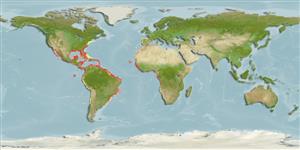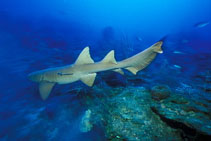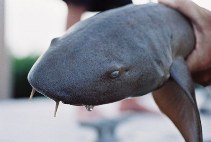Ginglymostoma cirratum (Bonnaterre, 1788)
Nurse shark
把你的觀察加入 Fish Watcher
| Native range | All suitable habitat | Point map | Year 2050 |

|
| This map was computer-generated and has not yet been reviewed. |
| Ginglymostoma cirratum AquaMaps Data sources: GBIF OBIS |
Dominican Republic country information
Common names:
Gata
Occurrence: native
Salinity: brackish
Abundance: | Ref:
Importance: | Ref:
Aquaculture: | Ref:
Regulations: | Ref:
Uses: no uses
Comments:
National Checklist:
Country Information: https://www.cia.gov/library/publications/resources/the-world-factbook/geos/dr.html
National Fisheries Authority: ttp://www.cep.unep.org/rep_dom/Rep_Dom.htm#SEA-PESQUERO
Occurrences: Occurrences Point map
Main Ref: Compagno, L.J.V., 1984
National Database:
Occurrence: native
Salinity: brackish
Abundance: | Ref:
Importance: | Ref:
Aquaculture: | Ref:
Regulations: | Ref:
Uses: no uses
Comments:
National Checklist:
Country Information: https://www.cia.gov/library/publications/resources/the-world-factbook/geos/dr.html
National Fisheries Authority: ttp://www.cep.unep.org/rep_dom/Rep_Dom.htm#SEA-PESQUERO
Occurrences: Occurrences Point map
Main Ref: Compagno, L.J.V., 1984
National Database:
Common names from other countries
分類 / Names 俗名 | 同種異名 | Catalog of Fishes(屬, 種) | ITIS | CoL | WoRMS | Cloffa
Elasmobranchii 板鰓亞綱 (鯊魚與魟魚) (sharks and rays) > Orectolobiformes (Carpet sharks) 鬚鯊目 (Carpet sharks) > Ginglymostomatidae (Nurse sharks) 鉸口鯊科 (Nurse sharks)
Etymology: Ginglymostoma: ginglymus (Gr.), hinge; stoma (Gr.), mouth, presumably referring to how corner of mouth has a hinged appearance (See ETYFish); cirratum: Latin for having tendrils, referring to elongated nasal barbels (See ETYFish).
More on author: Bonnaterre.
Etymology: Ginglymostoma: ginglymus (Gr.), hinge; stoma (Gr.), mouth, presumably referring to how corner of mouth has a hinged appearance (See ETYFish); cirratum: Latin for having tendrils, referring to elongated nasal barbels (See ETYFish).
More on author: Bonnaterre.
Environment: milieu / climate zone / depth range / distribution range 生態學
海洋; 半鹹淡水 礁區魚類; 深度上下限 0 - 130 m (Ref. 43278), usually 1 - 35 m (Ref. 40849). 亞熱帶的; 44°N - 35°S, 122°W - 10°E (Ref. 43278)
分布 國家 | FAO區域 | 生態系 | 發現紀錄 | Point map | 簡介 | Faunafri
Western Central Atlantic: Rhode Island to southern Brazil (south to Rio de Janeiro), including Gulf of Mexico and Caribbean coasts, although (exceptionally from Rhode Island to Texas), Bermuda; Eastern Central Atlantic: Cape Verde Islands, Senegal, Cameroon to Gabon, and rarely north to Bay of Biscaye, France (ref. 43278). Populations in eastern Pacific refer to Ginglymostoma unami Del Moral-Flores et al., 2015 (Ref. 113902).
西大西洋: 羅德島州,美國到巴西南部, 包括墨西哥灣與加勒比海,安地列斯群島。 東大西洋: 維德角到加彭; 偶而被發現於法國。 東太平洋: 加州灣與墨西哥的下加利福尼亞南部到祕魯。 近親魚種被發現於印度洋。
西大西洋: 羅德島州,美國到巴西南部, 包括墨西哥灣與加勒比海,安地列斯群島。 東大西洋: 維德角到加彭; 偶而被發現於法國。 東太平洋: 加州灣與墨西哥的下加利福尼亞南部到祕魯。 近親魚種被發現於印度洋。
Length at first maturity / 大小 / 重量 / 年齡
Maturity: Lm 235.0, range 230 - 240 cm
Max length : 430 cm TL 雄魚/尚未辨別雌雄; (Ref. 96339); common length : 304 cm TL 雄魚/尚未辨別雌雄; (Ref. 247); 最大體重: 109.6 kg (Ref. 40637); 最大年齡: 25 年 (Ref. 72467)
Max length : 430 cm TL 雄魚/尚未辨別雌雄; (Ref. 96339); common length : 304 cm TL 雄魚/尚未辨別雌雄; (Ref. 247); 最大體重: 109.6 kg (Ref. 40637); 最大年齡: 25 年 (Ref. 72467)
簡短描述 檢索表 | 型態特徵 | 形態測量圖
背棘 (總數) : 0. Moderately long barbels, nasoral grooves present but no perinasal grooves, mouth well in front of eyes, spiracles minute, precaudal tail shorter than head and body, dorsal fins broadly rounded (the first much larger than the second and anal fins), caudal fin moderately long, over 1/4 of total length, yellow-brown to grey-brown in color, with or without small dark spots and obscure dorsal saddle markings (Ref. 247). Head blunt, mouth inferior, pair of conspicuous barbels between nostrils (Ref. 26938).
中等長度的觸鬚 , 鼻溝存在的但是沒有鼻孔緣的凹槽 , 嘴在眼正前方, 呼吸孔細小的, 肛前尾短於頭部與身體, 背鰭寬廣地圓的 (第一個比第二背鰭與臀鰭大很多), 尾鰭中等長度的, 超過全長中的 1/4, 黃褐色到灰褐色顏色, 具有或者沒有小的深色斑點與暗的背部鞍狀斑紋.(參考文獻 247) 頭部鈍的, 嘴下方的, 在鼻孔之間的成對顯著的觸鬚.(參考文獻 26938)
中等長度的觸鬚 , 鼻溝存在的但是沒有鼻孔緣的凹槽 , 嘴在眼正前方, 呼吸孔細小的, 肛前尾短於頭部與身體, 背鰭寬廣地圓的 (第一個比第二背鰭與臀鰭大很多), 尾鰭中等長度的, 超過全長中的 1/4, 黃褐色到灰褐色顏色, 具有或者沒有小的深色斑點與暗的背部鞍狀斑紋.(參考文獻 247) 頭部鈍的, 嘴下方的, 在鼻孔之間的成對顯著的觸鬚.(參考文獻 26938)
Found on continental and insular shelves. Solitary (Ref. 26340) and sluggish fish, often encountered lying on the bottom (Ref. 9987). Nocturnal, feeding on bottom invertebrates such as spiny lobsters, shrimps, crabs, sea urchins, squids, octopi, snails and bivalves, and fishes like catfishes, mullets, puffers and stingrays. Ovoviviparous with 21 to 28 young in a litter (Ref. 9987, 43278). Kept in captivity for researches. May attack humans if they are molested or stepped upon accidentally. Edible, but mainly valued for its hide, which makes extremely tough and durable leather (Ref. 9987). Common over shallow sand flats, in channels, and around coral reefs; young may be found among prop roots of red mangroves (Ref. 26938).
棲息於大陸棚與島嶼棚了。 一種獨居性 (參考文獻 26340) 與緩動性的魚, 時常見到了棲息於底部。 (參考文獻 9987) 夜行的, 吃底棲無脊椎動物例如棘龍蝦,蝦,螃蟹,海膽,烏賊,章魚,蝸牛與二枚貝 , 與魚例如鯰魚,烏魚,河豚與魟。 卵胎生的具有 21 到 28 幼魚在一胎。 為研究畜養於繁殖場了。 如果他們被干擾或不小心踩到,可能攻擊人類。 可食用的, 但是主要的價值在它的隱藏, 這製造非常強硬而持久的皮革.(參考文獻 9987) 在峽道中,普遍在水淺的沙地淺灘上, 與珊瑚礁的周圍; 幼魚可能在紅色紅樹林的支柱根之中被發現於。 (參考文獻 26938)
棲息於大陸棚與島嶼棚了。 一種獨居性 (參考文獻 26340) 與緩動性的魚, 時常見到了棲息於底部。 (參考文獻 9987) 夜行的, 吃底棲無脊椎動物例如棘龍蝦,蝦,螃蟹,海膽,烏賊,章魚,蝸牛與二枚貝 , 與魚例如鯰魚,烏魚,河豚與魟。 卵胎生的具有 21 到 28 幼魚在一胎。 為研究畜養於繁殖場了。 如果他們被干擾或不小心踩到,可能攻擊人類。 可食用的, 但是主要的價值在它的隱藏, 這製造非常強硬而持久的皮革.(參考文獻 9987) 在峽道中,普遍在水淺的沙地淺灘上, 與珊瑚礁的周圍; 幼魚可能在紅色紅樹林的支柱根之中被發現於。 (參考文獻 26938)
Life cycle and mating behavior 成熟度 | 繁殖 | 產卵場 | 卵 | 孕卵數 | 仔魚
Ovoviviparous, with 21 to 28 young in a litter. Development of young in the uterus being sustained by a large supply of yolk. Females give birth in late spring and summer in waters off Florida. During courtship, a pair sometimes a triplet of adults engaged in synchronized parallel swimming. While on it, the male may grab one of the female's pectoral fins with his mouth which induces the female to pivot 90° and roll on her back on the bottom. Then the male inserts a clasper in her vent, and then roll on his back beside the female. Pair may break apart and depart rapidly after copulation or the male may remain motionless on the subtrate as if recovering from the mating bout (Ref. 49562). Not all attempts of males to copulate with a female nurse shark result in successful fertilization, females may employ avoidance by 'pivotting and rolling' to escape from male attention (Ref. 49562). Or females may 'lie on back' and rest motionless and rigidly on the substrate (Ref. 51113, 49562). On the contrary, females send signals of readiness to copulate with males by arching their body toward their male partner and cupping the pelvic fin (Ref. 51126, 49562). Male nurse sharks may mate with many females over several weeks (polygyny) and vice versa (polyandry) (Ref. 49562). Also Ref. 205.西大西洋: 羅德島州,美國到巴西南部, 包括墨西哥灣與加勒比海,安地列斯群島。 東大西洋: 維德角到加彭; 偶而被發現於法國。 東太平洋: 加州灣與墨西哥的下加利福尼亞南部到祕魯。 近親魚種被發現於印度洋。
主要參考資料
Upload your references | 參考文獻 | 合作者 : Compagno, Leonard J.V. | 合作者
Compagno, L.J.V., 1984. FAO Species Catalogue. Vol. 4. Sharks of the world. An annotated and illustrated catalogue of shark species known to date. Part 1 - Hexanchiformes to Lamniformes. FAO Fish. Synop. 125(4/1):1-249. Rome, FAO. (Ref. 247)
IUCN 瀕危狀態 (Ref. 130435: Version 2024-2)
次級保育類動物, 見 IUCN 紅皮書 (VU) (A2bcd); Date assessed: 05 July 2019
人類使用
漁業: 低經濟; 游釣魚種: 是的; 水族館: 公眾的水族館
FAO(漁業: 產生, 魚種描繪; publication : search) | FishSource | 周邊海洋
更多資訊
Population dynamics
成長參數
Max. ages / sizes
Length-weight rel.
Length-length rel.
長度-頻率
Mass conversion
入添量
豐度
成長參數
Max. ages / sizes
Length-weight rel.
Length-length rel.
長度-頻率
Mass conversion
入添量
豐度
Physiology
Body composition
Nutrients
耗氧量
游泳類型
游泳速度
Visual pigments
Fish sound
Diseases & Parasites
Toxicity (LC50s)
Body composition
Nutrients
耗氧量
游泳類型
游泳速度
Visual pigments
Fish sound
Diseases & Parasites
Toxicity (LC50s)
工具
Bio-Quiz | E-book | 野外調查 | 長度- 頻率 Wizard | 生活- 歷史的工具 | 分布圖 | Classification Tree
| Catch-MSY |
特別的報告
下載 XML
網路資源
Aquatic Commons | BHL | Cloffa | Websites from users | 檢查 FishWatcher | CISTI | Catalog of Fishes(屬, 種) | DiscoverLife | DORIS | ECOTOX | Faunafri | Fishtrace | GenBank(基因組, 核甘) | GloBI | GOBASE | GoMexSI (interaction data) | | Google Books | Google Scholar | Google | IGFA World Record | MitoFish | 國家資料庫 | Otolith Atlas of Taiwan Fishes | 公眾的水族館 | PubMed | Reef Life Survey | Scirus | SeaLifeBase | 樹狀分類階層 | Wikipedia(去, 搜尋) | World Records Freshwater Fishing | 動物學的記錄
Estimates based on models
Preferred temperature (Ref. 115969): 22.3 - 28, mean 25.5 (based on 798 cells).
Phylogenetic diversity index (Ref. 82804): PD50 = 0.8125 [Uniqueness, from 0.5 = low to 2.0 = high].
Bayesian length-weight: a=0.00417 (0.00157 - 0.01105), b=3.08 (2.85 - 3.31), in cm Total Length, based on LWR estimates for this (Sub)family-body shape (Ref. 93245).
營養階層 (Ref. 69278): 4.2 ±0.2 se; based on diet studies.
回復力 (Ref. 120179): 低的, 最小族群倍增時間4.5 - 14 年 (K=0.14; tmax=25; Fec=21-28).
Fishing Vulnerability (Ref. 59153): Very high vulnerability (90 of 100).
Climate Vulnerability (Ref. 125649): High vulnerability (65 of 100).





